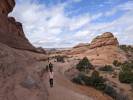Moapa Valley towns steeped in history
The verdant Muddy River Valley, better known as Moapa Valley, assumes a quiet demeanor that belies a long and sometimes turbulent past. The scenic river valley is about an hour’s drive from Las Vegas by way of Interstate 15 north.
Rooted firmly in agriculture because of its abundance of water in this arid region, the valley supports thriving little communities and some of the few remaining farms and ranches in Clark County.
Exiting I-15 at Glendale, state Route 168 explores Moapa Valley northwest of the highway along the Upper Muddy River. Continue a couple of miles beyond the Glendale exit to reach state Route 169, the highway south along the river through Logandale and Overton toward Lake Mead.
As built up as it appears now, Moapa Valley was home to even more people in the past. Nearly 1,000 years ago, the valley was populated by about 10,000 people living in many pueblo-style villages. It was the westernmost extension of a far-flung culture that stretched across Northern Arizona and Southern Utah from the Four Corners region. Known as the Anasazi, or Ancestral Puebloans, these people farmed, mined salt and turquoise and traded over long distances. Theirs was the culmination of cultures that developed over a span of about 10,000 years from nomadic hunters to successful farmers and pueblo builders. Then, by about A.D. 1150, they disappeared, leaving behind mystery, ruins and artifacts.
To find out more about these ancient people, stop at the Lost City Museum in Overton, a state repository for archaeological artifacts and treasured private collections. The museum sits on the site of an ancient pueblo on a bluff just west of the valley at the south end of the pioneer-era town. The museum is open from 8:30 a.m. to 4:30 p.m. daily, except a few holidays. Entrance costs $5 per person.
Other cultures followed, including the Paiutes, who lived there when the first permanent nonnative settlers, the Mormons, arrived in the region. Spreading out from Utah in the late 1800s, the Mormons established more than 300 communities across the West, including a string of towns along the Muddy River, which joined the Virgin River, or Rio Virgen, a tributary of the Colorado River.
Mormon settlement began in 1865 when the church sent colonists to establish a fort called St. Joseph on a bluff on the east side of the Muddy River just north of present-day Overton, which was settled in 1869. Soon, adobe buildings and a wooden grist mill marked the settlement near the fort. The mill soon ground salt, corn and wheat. In 1867, St. Joseph was big enough to have its own post office, but the following year, a fire swept through the town. By 1869, most settlers had relocated a couple of miles north of the original site, near today’s Logandale.
Several neighboring towns were also established, including St. Thomas in 1865 and West Point, in the upper valley near where the Glendale exit is today, in 1869. West Point struggled and failed, and St. Thomas was expanding when explorer John Wesley Powell passed through in 1869.
Utah Territory created Rio Virgen County and named St. Joseph the county seat about the same time that the Arizona Territory, also claiming the valley, created Pah-Ute County and named St. Thomas its county seat. The disputed territory was surveyed in 1870 and added to the state of Nevada.
In 1871, a Nevada assessor told the Mormons they owed Nevada two years of back taxes, so most of them left their holdings and moved back to Utah. Changes encouraged many Mormon settlers to return to the area in the 1880s.
Resettled St. Thomas was destined to drown when Lake Mead filled up behind Hoover Dam in the 1930s. Years of drought have exposed St. Thomas’ ruins, now reached by a trail. The National Park Service is seeking historical information and recollections of old St. Thomas.
Resettled as Logan’s Ranch after 1880, the town of Logandale emerged and grew. Visit the Old Logandale School, now a community center, to trace pioneer history through photos and artifacts.
Margo Bartlett Pesek’s Trip of the Week column appears on Sundays.




























